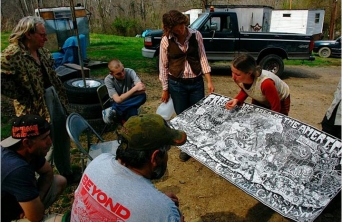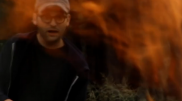Beehive Collective Joins The Intervention
Emma Bee of The Beehive Design Collective is currently touring across the U.S. to present her art organization's work -- creative murals that tell the narrative of social justice issues in America.
She’s one of 10 core members who do this full-time. It’s an all-volunteer group based in Machias, Maine that develops works in a collaborative atmosphere.
"We think of ourselves as cross-pollinating grassroots actions with art," she says. "The Beehive -- get it?"
Their latest work, called "The True Cost of Coal", marks the Beehive's shift from anti-globalization themes to climate change. Expansive, exhaustive, and meticulously illustrated, the poster was created to give the viewer an artistic history of one of mankind's oldest energy sources.
Inspired by the foldable back pages of Mad Magazine, the poster shows two very different worlds. When folded, it shows an untouched ecosystem. When unfolded, the "big picture" expands to include the effects of coal, from mountaintop removal to industrialization.
However, it goes beyond just environmental issues. One section of the artwork is dedicated to a movement of resistance -- a movement Emma says is a crucial, yet underscored part of the narrative of non-renewable energy.
Emma gave Counterspill a bit of her time to discuss the themes within "The True Cost of Coal" and gave us a way to turn a mountainous problem into destructible molehills.
Why did you choose to protest non-renewable energy with your latest project?
We were born out of the anti-globalization protest in Seattle, so, for the first six years, we focused on issues of global trade and Latin American issues. Our work especially in Latin American issues familiarized us with the issue of oil extraction. We learned about how those things were connected -- energy and globalization.
We knew that we’d eventually move toward climate change as we were already focusing on it in our smaller pieces and we had close friends that were beginning to organize against mountaintop removal. Finally, in 2008, a big opportunity really just fell from the sky and we got some start-up cash, so we thought we’d move ahead with it. It was perfect because it was right around the time when that was what people wanted to look at.
At first, we were naive. We quickly learned how complicated the issue really is, not only about the business of energy itself but in the human relationships and in the fact that it has been the source of people’s livelihoods for hundreds of year. It’s a tricky subject.
How did you collect the information for the mural?
We assembled the project team in March 2008 -- we had documentarians, researchers, illustrators, designers. We then took a three-and-a-half month research trip through Appalachia. There, we joined Mountain Justice, who had been doing work there for years and had community ties and experiences building relationships. It sort of snowballed from there and became an organic process of meeting people and collecting oral histories from not only activist groups but others -- from the people living there.
We wanted to know how we got to the point of blowing up mountains. What we found was a history of repression, resistance and resiliency in the region just by listening to how people live. I remember meeting this grandmother in the region who knows all the benefits of this variety of medicinal plants -- it struck me: we’re not just losing the environment, we're losing people who know how to live in that ecosystem.
A lot of people stereotype people there as poor, backward or uneducated. It's become a sacrifice zone for national energy policy.
Is there any other misconceptions about the fight against coal that you noticed?
What did stick out to us a lot is the real struggle about understanding it all. People can shout out a lot about wanting to end coal -- and we agree -- we need to move away from it as an energy source. But we also need to understand the aspects of different economies and different perspectives. Like, the jobs thing is really real, it’s a really real struggle. The people in that area have been working in the coal industry for 200 years. We need to think of those aspects, of moving toward a different economy and of understanding the complexity of it.
That’s another thing we tried to do with “The True Cost of Coal.” We wanted to walk through the energy system that is demanding the sacrifices. We’re all a part of this gigantic system that’s sucking energy -- it doesn’t matter what the resources are, we’re still going to need a massive amount of energy. So, there’s just as many problems with things like solar as there are with non-renewable energy. For example, there was this one student in one of the classes we visited that mentioned a Scientific American article saying how all of Europe could be powered if they covered North Africa with solar panels. Well, people live there -- they have their countries and lifestyles and culture. So that’s not something that’s feasible, but that's sometimes how people think about these issues.
If you could change the world with one idea, what would it be?
The way we think about it the terms “energy” and “power” -- they are often associated with electricity. But in the past, those things meant what people could accomplish. We can leverage that individual energy in community settings to accomplish this paradigm shift. It's true, looking at all these things is overwhelming. It’s scary -- it even scares us sometimes. But, we want to say that it’s okay to feel small because there’s a lot more energy and power within us. And it’s okay that the problem is so huge because that means that there are a lot of different places of intervention. There are a lot of places to focus our energy. Coal is used to make the concrete in the ground, to make consumer goods, it has surrounded us with opportunities to resist.
So, choose one way and take part, because there are a lot of people you can work with. Together, we can create collective energy.






